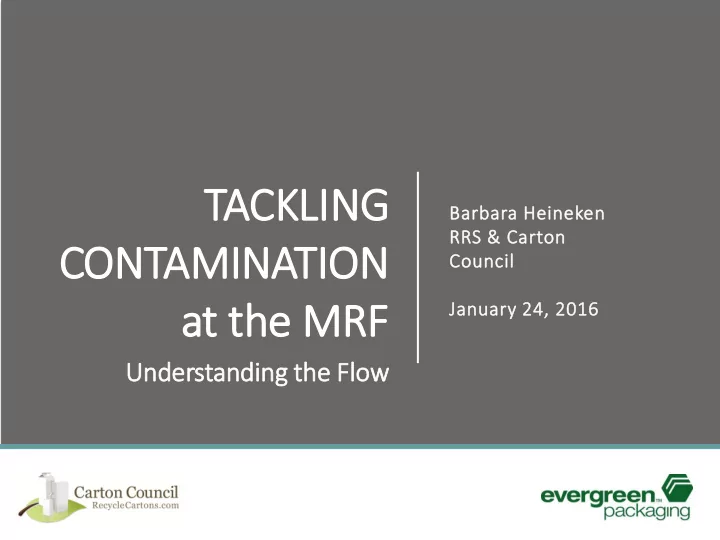

TACKLING Barbara Heineken RRS & Carton CONTAMINATION Council at the MRF January 24, 2016 Understandin ing th the Flo low 1
Who is the Carton Council? A group of carton manufacturers united to deliver long term, collaborative solutions to divert Ass Associate Mem ember valuable cartons from the landfill. 2
What are cart rtons? 3
Cartons contain valuable materials Made with 100% virgin fibers, cartons contain some of the best fiber still in the waste stream. Shelf- stable “ aseptic Sh ic ” cart rton ons Refrigerated “ gable top op ” cart rton ons • 74% paper, • 80% paper • 22% polyethylene • 20% polyethylene • 4% aluminum Car artons ar are Not ot Wax Coa oated 4
Target th the Recycling Su Supply Chain Our goal: Build carton recovery MATER ERIAL STRATEGY 5 5
Work Backwards fr from End Markets Build sustainable markets Create sustainable infrastructure Develop awareness and participation 6
COMMISSIONED BY PREPARED BY 7
COMMISSIONED BY PREPARED BY 8
Why? • The material mix at the MRF is constantly changing • Understanding how categories of materials flow will help the industry improve recovery Goals 9
Methodology 10
Plastic Materials Paper Materials Gable-top and aseptic cartons Bottles & Jars Beverage cups (hot & cold) Small/Large plastic containers Ice cream containers Small/Large plastic lids Clamshells Clamshells/Domes/Trays Trays Beverage Cups 11
MRFs Tested 12
Two Types of Analysis Where did study What was in each materials end up? of the target bales? Trash Residue (7) Other Mixed Paper (7) cHDPE Bottles Mixed Plastic (6) PET Bale (80) nHDPE Bottles 100 PET nHDPE cups Bale 13
Product Characterizations were Calculated for: Mixed Paper Mixed Paper cHDPE Newspaper 1 Newspaper PET nHDPE Cartons Mixed Plastics Residue 2 1. Some facilities only marketed one grade of paper 2. Also included a HDPE/PP Tubs and Lids grade 14
What did we learn? 15
Overall loss rates of plastic materials varied from 3% to 12% Likely reasons for high loss: Screen maintenance is key to consistent • 8% loss at large facility had unusually performance compacted and wet material due to equipment • Clean screens of material that are failures wrapped around the shafts and snowstorms • Replace worn and damaged discs • 12% loss at both medium facilities likely had worn disc screen discs More screens produced better Material preparation had a strong effect separation • Minimize compaction of material by • Large facilities both had 1 extra screen residents and collection trucks than medium facilities and had lower loss • Keep material dry rates of plastics to the paper stream Avoid overloading screens past their design throughput 16
Loss rate of packaging materials to the paper streams No material is perfect • Even plastic bottles had on average 5% loss to the paper stream Rounder materials like cups, containers and bottles had lower average loss rates than square materials like clamshells and cartons Materials that held their shape had a higher tendency to flow to the container line than those that flattened • Lightweight water bottles had a loss rate of 15% Loss rates above are to the paper stream only, each type also had losses to other commodities and to the residue 17
Increasing benefits as stream evolves into being more diverse and lightweight Manual sorters can be overwhelmed by number of individual pieces and confused by similar looking resins or packages (i.e. clear PET and clear PP) 18
Factors Improving a Package’s Recovery 19
Example Results 20
Where Did the Material End Up? Small, regular weight PET beverage bottles All CHDPE bottles PET Bottles – Small (< 1L), regular weight cHDPE Bottles - All Size – not too small Size – noted numerous small single serving type bottles Holds 3D shape relatively well Holds 3D shape relatively well Very common material in the MRF Very common material in the MRF 21
Where Did the Material End Up? Small PET Containers All CHDPE Containers Size – many small containers Size – noted numerous small single serving type containers More likely to flatten due to open top More likely to flatten due to open top Very common material in the MRF Very common material in the MRF, but easily confused with PP containers 22
Where Did the Material End Up? Cartons Paper beverage cups Size – not many small school milk cartons observed Size – not too small Holds 3D shape relatively well More likely to flatten due to open top Smaller percentage of overall stream Not currently accepted by any of the test MRFs 23
Conclusions Each player in the recycling value chain has a role to play to improve recovery Pac ackagin ing De Desi signers Municip ipali litie ies Design with recovery in mind Work with MRFs to add new materials and educate residents on proper material preparation MRF Equip ipment De Desig igners MRF Operators Research designs to improve Adequate separation equipment separation of new materials and continual maintenance improves separations 24
Recommend
More recommend